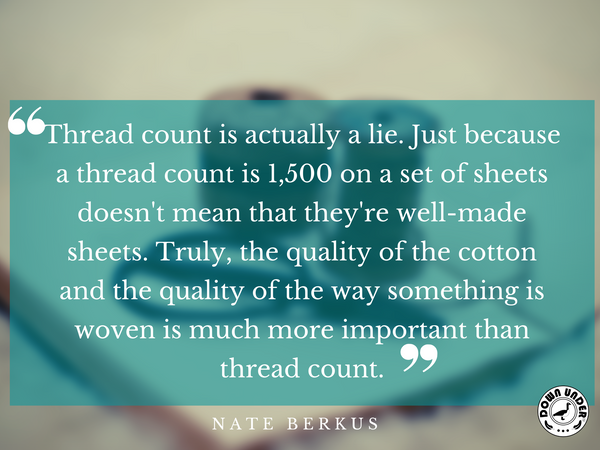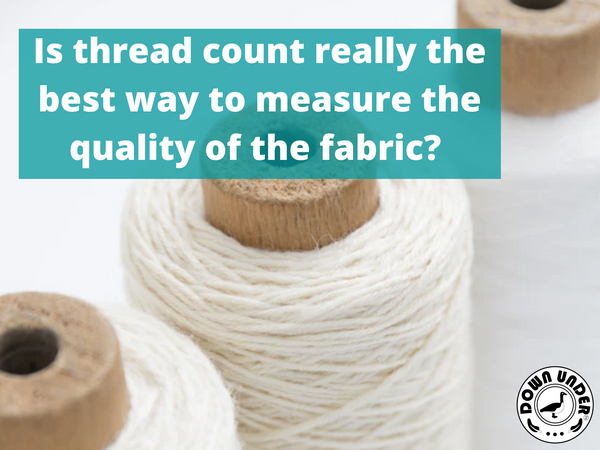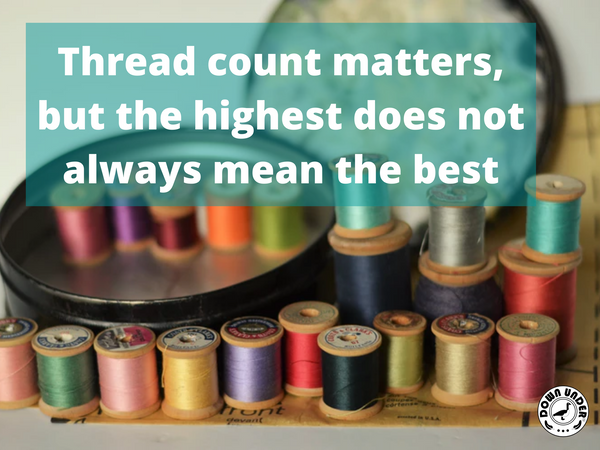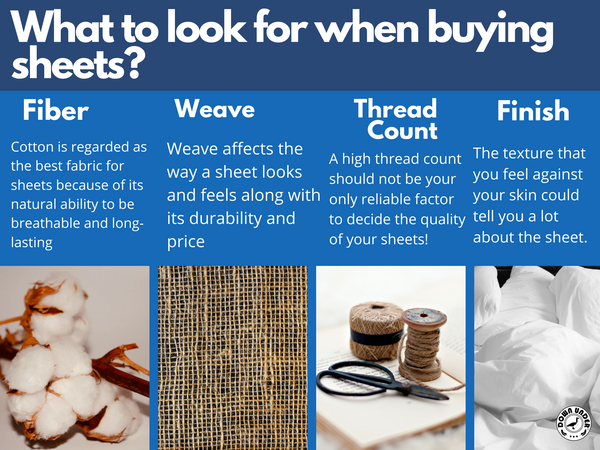
When shopping for bedding you might have come across the term thread count. And then all the other questions surrounding thread count come to your mind!!
Looking for sheets with more thread count? But wondering does it really make a difference if the thread count is higher. What is the difference between higher vs. lower thread count? Why are sheets with more thread count so expensive?
Don’t worry you have come to the right place take a deep breath!! No need to look elsewhere for answers because we have compiled a list of all your questions here.
We understand that thread counts can be confusing as they may appear as a technical term for some. There are also a lot of misconceptions associated with thread count; the higher the thread count means a more luxurious sheet. But let me tell you it’s not always the thread count that matters! There are many factors that contribute to making great linens such as softness, comfort, and texture.
What Is Thread Count?
Thread count can be understood as the number of threads per square inch of fabric to help consumers gauge the sense of the quality on a purchase. Thread counts in linens can range from 100 to 12,000. This number is technically based on the number of threads being woven in a vertical and horizontal form, which looks like small squares as seen from a microscope. Extra threads can be woven into the linen weft in order to increase the thread count. Even though thread counts matter, they should not be the only thing you depend on when buying a sheet. Consider looking at material, weave, and ply.
A high thread count should not be your only reliable factor to decide the quality of your sheets! Rather you should look at the quality of fiber, the number of plies, and also the weave of yarns to select the best ones.
Keep reading to get a better understanding of what each of those means. “the main idea should be that the bedding feels soft and comfortable against your skin”
However, keep in mind higher thread count doesn’t necessarily mean a fabric will feel luxurious, soft, or ultra-soft or even super smooth. There are many other variables you should keep in mind, which can make your fabric look more appealing such as fiber quality, yarn size, type of weave, and also the finish.

Options for Bedding Materials
When it comes to bedsheet materials, there are lots of choices such as cotton, silk, jersey, flannel, organic cotton, polyester, wool, and microfiber. Let’s not get into specifics for each material just yet, but for now, just focus on cotton as it plays a huge role in understanding thread count.
Cotton, as you may know, has a natural breathable ability and is also one of the most picked sheet options. Cotton is made from a variety of fibers such as long-staple, short-staple as well as an extra-long staples. This helps classifies the different lengths of cotton plants and also plays a huge role in distinguishing the quality, strength, and smoothness of cotton. Short staples are the most common for everyday clothing use (for example- jeans), yet the lowest quality of cotton also known as the Upland cotton. Most fabrics made from this fiber are very low maintenance. With the increase in the length of the staple, the quality also increases as they become more durable and even softer over time. The extra-long and long fibers are the best choices for bedding items.

Types of Cotton
Whether it is for your bedding or your clothes, it is important to understand the types of cotton used available, to gain a better understanding of your clothing materials. There are three main types of cotton available:
- Pima: Softest and finest quality of cotton as it’s made from an extra-long staple giving it a very soft and durable result.
- Upland: Made from short cotton fibers. What’s great about this type of cotton is that it is very affordable and one of the most common.
- Egyptian:Just like Pima, Egyptian cotton is also made from an extra-long staple. This one is preferred by many as it’s made from the highest quality cotton staple and gives your sheets a soft and breathable ability.
Fiber quality is important for your bedding’s softness, weight and durability, find long stable combed cotton yarns make for softer stronger sheets
Staple can be understood as the length of the cotton fiber that creates stronger and finer yarns. With thread size matters, yarn size for sheets ranges from 40-100, depending on the fabric. Yarn can be single or multiple plies, they are twisted together.
The way the fabric is woven also plays a huge part in high-quality bedding thread; the thread count ranged up to 12,000. However, to reach that number of more than 400, multiple-ply yarns are inserted into the weaving process, to add to the bedding’s strength and durability. Depending on the weight of the fiber this could result in heavier and less subtle fabric. So higher thread count alone may not give up the feel you are looking for, after that many other processes are put in place such as using various techniques, to control shrinking, improve lustrously and add dye for color, to give you the perfect finest quality bedding.

Understanding Thread Counts and Their Impact on Quality
Over the last few years, many brands have been able to manipulate the manufacturing process to cause confusion with double & triple-ply fabrics. Linens thread count comes down to the type of fiber used for the bedding and not necessarily the amount of it being used.
A cheap material with thread counts over 1,500 won't feel as good as one made with good quality Egyptian or Pima thread with an honest thread count of 250. That's why you might see a 1200 thread count sheet set for $30 which is really usually made of microfiber of 100% polyester.
On the other hand, you might find pure combed cotton Egyptian sheets at a lower 300 thread count weave for double or triple the price but comparing the 2 products is misleading. These inflated thread counts bedding are made of inferior quality and not built to last or have much comfort. However, if you're shopping on a budget this may be what you need.
One of the most common ways the manufacturer’s expanding thread count is by using multiple yarns that are twisted together or even by counting each strand of yarn as separate threads. The multiple-yarn threads are not as durable as single- or two-ply threads. Another way industries increase thread count is by using low-quality fabrics with thinner threads.
A good quality luxurious soft sheet would have stronger thicker strands of threads which makes it more durable. When a material has denser strands, fewer of those strands are able to fit in one square inch, resulting in a lower number. It is better to choose a high-quality fabric with a lower thread count than buy something which is less durable but has a high thread count.
Keep in mind, low thread count does not mean low-quality sheets, there are some sheets out there with a thread count of 200; which have a very nice soft touch and luxurious finish; that it might feel like they have a higher thread count. The ideal sheet would have a thread count between the 300 – 400 range.
"Thread count matters, but the highest does not always mean the best!"
Over the years thread count has just become a fancy word for quoting the quality of your sheets. The main idea however remains the same the finer the thread you can weave the softer the fabric will be.

In the past, thread count was used as a measure of quality; the higher the TC the better the quality of the material. However, it should not be the only factor for your linens anymore. Higher thread counts can surely make for better sheets, but the quality of the fabric also plays a huge role. Keep in mind, longer fibers, make for better stronger, and smoother yarns. A sheet with a lower thread count but a better quality fabric could feel softer even after many washes as compared to a sheet with a higher thread count yet lower-quality fabric.
What Else to Look for When Shopping for Linens?
Quality of Fiber
This step refers to the quality of the weaving process of your sheet. Cotton is regarded as the best fabric for sheets because of its natural ability to be breathable and long-lasting. Always check the ply of your sheets- are they multiple-ply? Or single/ 2- ply? Sheets with one-ply and 2 ply options are considered to be a better choice for linens. The longer the fibers, the more easily they can be spun into smoother, stronger, finer yarn or thread.
- Alinen bed sheet might have a lower thread count than a cotton sheet but still could be of better quality.
- Asilk fabric’s quality does not depend on the thread count, as silk threads have different measurements of fibers.
Finishing Touch
Keep in mind many manufacturers use chemical-based polishes to give your sheet a shiner and softer look. The ideal sheet should look and feel better with each wash and not the other way around. The finishing touch is one of the last steps taken when your linens are designed as they help add softness, texture, and stability to your fabric.
Feel
This is one of the most important factors when selecting your perfect bed sheet. Always ask yourself if buying in person- does it feel soft? The texture that you feel against your skin could tell you a lot about the sheet.
What’s all the hype with higher thread counts!!
Why Thread Count is Not Always the Matter?
It may be an easy concept to understand but does not always matter. Thread count sometimes has very little to do with the quality of the sheet. Many textiles are sprayed with silicone which makes them softer for a while but washes off with time.
When looking for a good quality bedding sheet, do check the price, sometimes it can be an indicator of a good quality sheet. Other things you may want to keep in mind are long-staple and extra-long-staple, as they are softer and more durable. A good quality sheet can easily last 10 years or more.
A little tip: honestly good quality sheets should not have a thread count over 1000. This is when you should be careful.
Ultimately the final decision is yours to make, but remember if you have kids or pets are home you may want to consider buying washable sheets made from cotton materials or if you are looking for something more luxurious you may want to have a look at silk linens.
If you're looking for quality contact us at Down Under Bedding as we have early 40 years of experience delivering a great night's sleep. Contact us if you want the correct information to help you have a comfortable night’s sleep.
Hope our blog helped you get a better understanding of thread count!!
Sleep tight! XOXO










Blair Smith
January 15, 2023
Really interesting post!